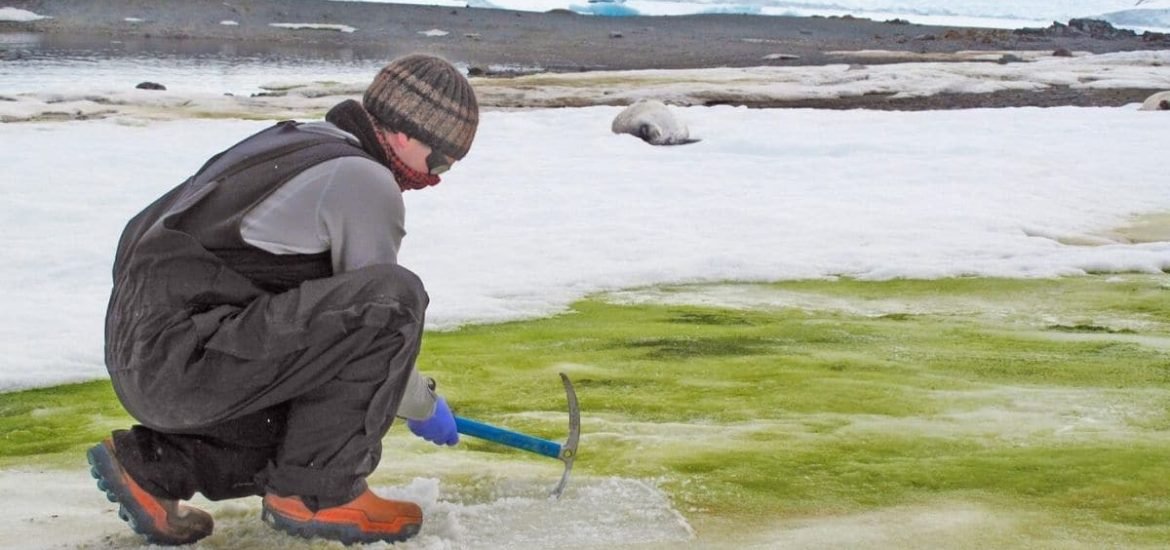
In summer, parts of Antarctica are turning bright green as algae bloom across the surface of the melting snow. Now, scientists have created the first large-scale map of microscopic algae on the Antarctic peninsula, published on 20 May in Nature Communications (1). The algae, which provide an important terrestrial carbon sink, are likely to spread across the continent as global temperatures continue to increase.
“A lot of people think Antarctica is just snow and penguins”, said Dr Matt Davey of Cambridge University, who was one of the lead researchers involved in the study. “In fact when you look around the fringe there is a lot of plant life”. Antarctica is home to several types of algae that grow on slushy snow and absorb carbon dioxide from the atmosphere.
The scientists from the University of Cambridge and the British Antarctic Survey used satellite images and ground observations, taken over two summers (between 2017 and 2019), to create the first large-scale map of algae on the peninsula. Blooming algae turn the surface of the snow bright green in parts of Antarctica, which incredibly, can be viewed from space, according to the authors. The new map will provide a baseline to assess how fast Antarctica is turning green as a result of climate change.
The blooms are mainly found on small, low-lying islands around the peninsula, where some of the most intense global warming has occurred, and are less visible in colder, southern regions of the great white continent. The algal distribution is also strongly influenced by local birds and mammals, whose excrement acts as a highly nutritious natural fertilizer to accelerate growth. Indeed, more than 60 per cent of blooms were found within five kilometres of a penguin colony.
The team of researchers identified more than 1,600 separate green algae blooms on the barren continent, covering a total surface area of almost two square kilometres. This equates to a carbon sink of about 479 tonnes per year – equivalent to the emissions of around 875,000 car journeys.
“Even though the numbers are relatively small on a global scale,” Davey explained, “in Antarctica where you have such a small amount of plant life, that amount of biomass is highly significant”.
Moreover, the total amount of carbon held in snow algae in Antarctica is probably much larger since carbon dioxide is also taken up by red and orange algae, which were not measured in this study.
“Snow algae are a key component of the continent’s ability to capture carbon dioxide from the atmosphere through photosynthesis”, said Davey. The researchers believe global warming will further increase the span of the algae, which could have a significant impact on carbon budgets as more algae absorb more carbon. But could also affect so-called albedo – the amount of sunlight reflected off the surface of the earth without being absorbed. White snow reflects 80 per cent of radiation that hits it, whereas green snow only reflects around 45 per cent. However, the researchers think reduced albedo is unlikely to make an impact on a meaningful scale.
The algae also interact with fungal spores and bacteria, which Davey says “could be the beginning of a new ecosystem”.
(1) Remote sensing reveals Antarctic green snow algae as important terrestrial carbon sink
Gray, A. et al. Nature Communications (2020). DOI: 10.1038/s41467-020-16018-w
Photo: Dr Matt Davey sampling snow algae at Lagoon Island, Antarctica. Credit: Sarah Vincent
Add this to your file: NASA – Supervolcano may be melting Antarctic ice sheet from below.
NASA scientists admit that a massive heat source almost as hot as the Yellowstone supervolcano may be melting the Antarctic ice sheet from below.
How can lakes and rivers be flowing beneath the ice unless there’s a heat source down there?
A new NASA study adds evidence that a geothermal heat source called a mantle plume lies deep below Antarctica’s Marie Byrd Land, explaining some of the melting that creates lakes and rivers under the ice sheet. Although the heat source isn’t a new or increasing threat to the West Antarctic ice sheet, it may help explain why the ice sheet collapsed rapidly in an earlier era of rapid climate change, and why it is so unstable today.
Their paper, “Influence of a West Antarctic mantle plume on ice sheet basal conditions,” was published in the Journal of Geophysical Research: Solid Earth.
Alan Buis
Jet Propulsion Laboratory, Pasadena, California
NASA’s Earth Science News Team2017-291Last Updated: Nov. 7, 2017Editor: Tony Greicius
______________________
NASA – Supervolcano may be melting Antarctic ice sheet from below.
Complete NASA Press Release:
https://www.nasa.gov/feature/jpl/hot-news-from-the-antarctic-underground
Turning into pre-flood conditions.
Bring on the warmth!
This is very sad about that Antarctica is turning Green because of human being and the impact of Global Warming even during the Covid-19 pandemic.